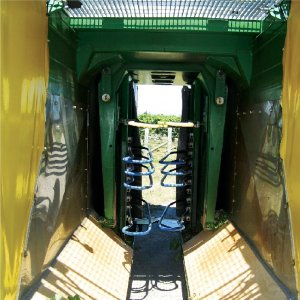Until recently, the major method used in New Zealand was to thin crops, either by limiting cane numbers at pruning or by hand thinning fruit after flowering. However in frost prone regions, (a lot of New Zealand falls into that category) the fear a late spring frost will impact on yields means some growers are reluctant to limit cane numbers, just in case. There is also the risk of poor flowering conditions, again limiting yields on lower cane numbers.
Fruit thinning straight after flowering is costly and also can see the vine compensating by placing its energy into larger berries. Fruit thinning closer to veraison, sees costs increase dramatically. Removing entire canes prior to veraison is also costly, time consuming and may cause increased vegetation on the vine.
In 2007 NZ Winegrowers instigated research into the potential of mechanical thinning, similar to methods undertaken in both Australia and the US.
The research team has recently received another three years of funding from Sustainable Farming Fund and NZ Winegrowers to explore not only the cost benefits, but also to ascertain whether it will reduces botrytis risk. (The importance of mechanical thinning on botrytis control is the second prong of the on-going research.)
Initial trials were in Marlborough, this has now expanded to include Hawkes Bay.
In Marlborough mechanical thinning is being trialled in four vineyards – two Sauvignon Blanc, one Pinot Noir and one Pinot Gris. In Hawkes Bay the trials will be evaluated in Sauvignon Blanc and Pinot Gris.
No specialised equipment has been necessary for the trials, with the researchers using a Nairn 123OLS machine harvester.
With its belts removed and wooden panels inserted, the thinned fruit is able to fall to the ground directly beneath the canopy.
Three beaters have been set up on each side of the harvester and the machine travels at a speed of 3.2 km/hr. The beater speeds are 400 strokes per minute for lightly thinned and 450 strokes per minute for heavier thinning.
The consistency and the cost saving ability are two of the major advantages, Dominic Pecchenino a leading Marlborough Viticulturist says.
"You hardly remove any leaves, which is important in terms of the vine and photosynthesis. Also there is rarely any damage to the cane for the next season. It's another use of machinery that only comes out for about six weeks of the year, making it more cost effective."
In his address to last year's Romeo Bragato conference, Dr Mike Trought from Marlborough Plant and Food highlighted some of the cost savings.
• During the study the cost per m row was $0.13 cents, versus an estimated $0.17 or $0.18 if undertaken manually
• Thinning could be undertaken in a considerably shorter time frame than manually
• The machine reduced yields between 20 and 40% of the un-thinned control
• It may reduce the risk of botrytis infection – which if proven further could reduce the need for late season spraying
• Removing one spray application during the season could save approximately $5.5 million per annum
Included in the trials being undertaken this season the influence of mechanical thinning on not only yield, but also berry size, and fruit composition will be fully investigated.
This email address is being protected from spambots. You need JavaScript enabled to view it. ■



